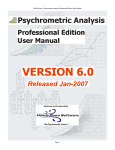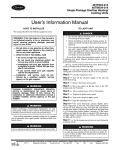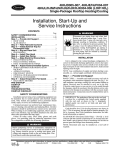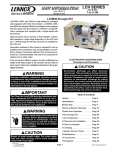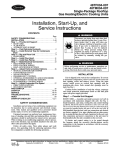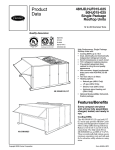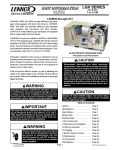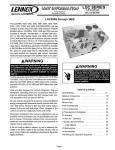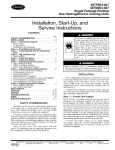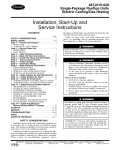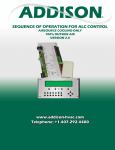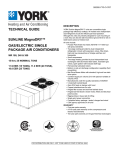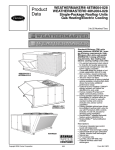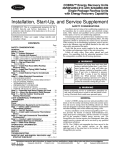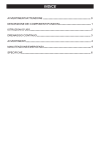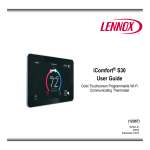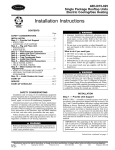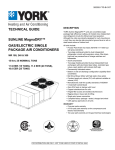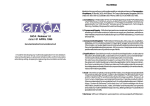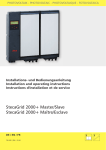Download Hot Gas Reheat Optio..
Transcript
Engineering Bulletin RT-PRB011-EN Library Product Literature Product Section UNITARY Product ROOFTOP - Light Commercial Model T/Y Dehumidification Option Literature Type Engineering Bulletin Sequence 1 Supersedes New 02/01/2004 SUBJECT: Trane® Precedent™/Voyager™ Dehumidification (Hot Gas Reheat) Option INTRODUCTION: The purpose of this Engineering Bulletin is to explain the Sequence of Operation, Features and Benefits, Competitive Comparison, and typical application for the Hot Gas Reheat Dehumidification option for Trane Precedent and Voyager II (to be announced) units. The topics to be discussed are: A. Overviews B. Features and Benefits C. Application Considerations D. Sequence of Operation E. Competition F. Conclusions A. Overview Trane has developed hot gas reheat option for the Voyager II and Precedent units. This is the dehumidification option for Trane Precedent and VII products. The dehumidification option is a hot gas reheat coil located down stream of the evaporator coil. The hot gas reheat coil was designed to deliver 70 – 75°F air to the space. 1 B. FEATURES AND BENEFITS Table 1 describes the benefits or Trane’s dehumidification offering. The primary advantage of the Trane hot gas reheat coil is that it is a complete integrated offering that can provide 70-75°F air to the space during the most critical time of the year (part load). Trane’s dehumidification offering really shines at part load conditions. One of the best conditions to show the performance of this unit is a cool rainy day (68 Dry Bulb/67 Wet Bulb). Table 1 Trane Dehumidification Benefits Benefit Allows for increased outdoor air ventilation Reduce humidity levels while increasing comfort Independent cooling and Dehumidification operation Cleanable Price Description The dehumidification option will allow the customer to control humidity directly with a humidity sensor. As the space temperature moves closer to the recommended ASHRAE comfort envelope, occupants feel more comfortable. The Trane dehumidification option was designed with the goal of operating within this envelope Demand dehumidification. The Trane dehumidification option has a separate humidity sensor that enables the 3 way reheat valve based off of space relative humidity. The hot gas reheat coil pivots to allow for easy access cleaning. Comfort is of value C. APPLICATION CONSIDERATIONS Suitable Applications In general, applications where non-peak load conditions can be dominated by latent loads are candidates for the dehumidification option. This includes many applications subject to ASHRAE Standard 62 requirements. Examples include: ¾ Schools — Heightened concerns about indoor air quality (IAQ) affect both new and existing applications. ¾ Restaurants — High exhaust and ventilation requirements are typical for this building type. ¾ Office and industrial buildings — Varying occupancy places varying demands on the HVAC system. ¾ Retail stores — Ventilation requirements and indoor refrigeration equipment create the perfect environment for humidity control systems. 2 Inappropriate Applications 100% outside air applications are not suitable for this dehumidification option. Very low dewpoint applications are not suitable for this option. Consider using an alternate solution designed specifically for that type of application. Examples include: ¾ Make up air paint booths ¾ Museums where very low Dew Point Temperatures are required Selling The Trane Dehumidification Option (based on the application) The most effective way to sell a Trane’s dehumidification option against the competition is on performance. Be sure to encourage customers not to be swayed by the performance claims of other potential suppliers. Use Figure 1 as an example for application selling. Conditions: ¾ 10 Ton Trane Precedent w/ dehumidification option ¾ 3000 CFM ¾ 68/67 Outdoor Air Temperature ¾ 75/63 Return Air Temperature ¾ 40% Outside Air Ventilation Requirement ¾ 72.6/64.6 Mixed Air Temperature Based on the cooling performance of the Trane Precedent we can follow each of the points on the psychometric chart on the next page. 3 Figure 1 55 0.20 0.25 0.30 SENSIBLE HEAT RATIO = Qs / Qt 0.35 90 50 1.30 200 BAROMETRIC PRESSURE: 29.921 in. HG °F WE TB UL BT EM PE RA TU RE - 1) Outdoor Air @ 68/67 and Return Air @ 75/63 combine to provide the resulting entering Mixed Air of 72.2/64.6 and 79.2 grains H2O/lb dry air. 13.2 % 40 45 13.0 40 30 32 3) Air passes over reheat coil, which adds sensible heat to the air. 12.6 10 12.8 35 30% 20% 100 90 80 RA 70 60 SA 40 50 60 Chart by: HANDS DOWN SOFTWARE, www.handsdownsoftware.com 10 STANDARD AIR 70 80 DRY BULB TEMPERATURE - °F 15 ENTHALPY - Btu per lb. of dry air and associated moisture 90 40 55 50 40 40 30 35 35 30 100 20 60 45 20 30 65 45 50 4) Air has gone from 61° Dew Point to 50 ° Dew Point and 67% R.H. to 45% R.H. Supply air is now at 55.2 grains H2O/lb. compared to the original 79.2. See moisture removal calculator for detailed information. Y HUMIDIT LATIVE 10% RE 25 70 110 DEWPOINT TEMPERATURE- °F 120 ENTHALPY- Btu per lb. of dry air and associated moisture °F 50 15 0.90 50 75 130 % 70 MAT % 50 SA' 0.95 20 25 20 10 10 0 0 110 0.55 0.60 0.65 0.70 0.75 0.80 0.85 0.90 0.85 0.80 0.75 0.70 0.65 0.60 0.55 0.95 1.00 0.50 SENSIBLE HEAT RATIO= Qs / Qt 13.6 13.4 55 HUMIDITYRATIO(or Specific Humidity) GRAINSOF MOISTUREPERPOUNDOF DRYAIR 90 % 80 % 65 0.50 140 0.45 VAPORPRESSURE- INCHESOF MERCURY dry air and ass ocia ted mo istu re per lb. of - Btu EN TH ALP Y 14.2 WE TB UL BT EM PE RA TU RE - 1.05 1.00 150 14.0 OD 0.45 80 35 70 1.10 55 160 80 75 % 60 20 15.0 14.8 1.15 170 40 60 1.20 0.40 45 13.8 2) Air passes over evaporator 30 coil. Compressor comes on and cools air and removes moisture along the compressor c25 r e 85 180 14.4 Actual Performance Trane Precedent 10 Ton Dehumidification HGRH unit @ 3000 CFM. 1.25 190 14.6 85 0.40 0.35 0.30 0.25 0.20 0.15 0.10 30 0.05 115 25 The results are outstanding! The final supply temperature to the space is 73.8 Degrees F (DB)/50.8 Dew Point. Based on these conditions the unit removed approximately 5.5 gallons of water/hour. Note: Please refer to the moisture removal calculator to calculate specific conditions. This is available on TraneNet http://tranenetclk1/oac/SHARED/lit/product/dehumidification/index.asp. 4 D. SEQUENCE OF OPPERATION How the hot gas reheat system works By extending compressor run time, you effectively remove more water from the air by dropping the temperature of the air as it passes over the evaporator coil, and increase latent capacity. All dehumidification is done as the air passes over the dx-cooling coil. By it's very nature; colder air can hold less moisture. The colder you can make that air, the more moisture you can remove. It is the reheating of that air back up to a neutral temperature that is the important feature. All the reheat coil does is add sensible heat to the dehumidified air returning it to a comfortable level before it enters the space. Sequence of Operation (Trane, Lennox®, York®, AAON®) Dehumidification demand only: When an installed zone humidity sensor (Trane, Lennox) indicates a relative humidity equal to or greater than the humidity setpoint or as initiated by the on/off signal from a humidistat, the dehumidification cycle is initiated. Economizers move to minimum position. When there is a demand for dehumidification, free cooling is not permitted. The hot gas reheat solenoid valve is energized and refrigerant moves from the compressor though the reheat coil. Mixed air passes over the evaporator dropping the sensible temperature of the air as well as removing moisture. The dehumidified air passes over the reheat coil which adds sensible heat The Dehumidification cycle is terminated when the zone humidity is reduced to 5% (3% Lennox) below the R.H. setpoint, the humidistat issues an off signal, or by any call for heating or full cooling. First stage cooling with reheat demand: Units will operate in dehumidification mode if there is both demand for dehumidification and first stage cooling. 2nd stage cooling or any heating call takes priority over dehumidification. The system will operate in cooling mode until the cooling demand is satisfied then the system will energize the dehumidification mode if the humidity call still exists. AAON (Modulating Reheat Valve vs. ON/OFF Valve) AAON has an option on their hot gas reheat units. AAON claims to be able to MODULATE or "control" their refrigerant through the reheat coil with their Hot Gas Control Valve Option. See rebuttal to that claim on the Competitive Comparison Table 2. They claim to be able to control to a specific reheated air temperature. For Trane the reheat coil is either on or off. Refrigerant is not modulated or "controlled" through the coil. The reheat temperature rise depends on a variety of conditions including ambient and entering air conditions. The system on, it is designed to provide reheated air at a temperature within the ASHRAE comfort zone though that specific temperature may vary. The following figures and tables will take you through the sequence of operation of typical hot gas reheat and liquid subcooling dehumidification systems. After which, Table 2 of the competition section provides a head-to-head comparison of the light commercial dehumidification systems in production. 5 Figure 2 HOT GAS REHEAT FLOW D e h u m id ific a tio n S y s te m s - R e fr ig e r a n t flo w w ith h o t g a s r e h e a t a c tiv a te d Aaon C h e c k v a lv e "D e h u m id ifie d a n d N e u tr a liz e d " A ir to S p a c e S o le n o id V a lv e H ot G as C o n tr o l V a lv e R e h e a t C o il E v a p o r a t o r C o il C ondenser C o m p re s s o r M ix e d In d o o r /O u td o o r A ir O u td o o r S e c tio n In d o o r S e c tio n TXV T r a n e , L e n n o x H u m id it r o l, Y o r k S u n lin e M a g n a D R Y C h e c k v a lv e "D e h u m id ifie d a n d N e u tr a liz e d " A ir to S p a c e S o le n o id V a lv e R e h e a t C o il E v a p o r a t o r C o il C ondenser C o m p re s s o r M ix e d In d o o r /O u td o o r A ir O u td o o r S e c tio n In d o o r S e c tio n TXV 6 Figure 3 Carrier Liquid Subcooling Coil Refrigerant Flow Carrier Moisture Miser Solenoid Valve "Dehumidified" Air to Space TXV Subcooler Coil Expansion Device Evaporator Coil Outdoor Section Indoor Section Mixed Indoor/Outdoor Air Condenser Compressor As humidity levels increase beyond humidistat set points, humidistat closes the liquid line solenoid valve. Hot liquid refrigerant from the condenser is then forced into subcooler coil. This hot liquid refrigerant is exposed to cold supply air from evaporator and is further subcooled to a colder temperature. This colder liquid refrigerant enters a TXV where it experiences a pressure drop. The refrigerant then enters a fixed expansion device for a second pressure drop. The refrigerant finally enters the evaporator coil at a temperature lower than during normal operation. This lower temperature causes the increase in latent capacity. Mixed air passes over the evaporator dropping the sensible temperature of the air as well as removing moisture. The air then passes over the subcooler coil, which adds a small amount of sensible heat depending on. This methodology does not create as much reheat temperature rise because the refrigerant flows into the reheat coil after it leaves the condenser, rather than after the compressor, and is too dependent on outside air conditions. It does dehumidify the air but cannot return the air to a comfortable "room neutral" temperature. Compared to true Hot Gas Reheat units, there is no real advantage to this design. 7 E. COMPETITION Competitive Comparison Table 2 Dehumidification System Competitive Comparison S = Strength (compared to Trane offering), W = Weakness (compared to Trane offering), N = Neutral (same/similar to Trane offering) Trane Aaon Lennox Design Approach (Aaon also claims this to be a control strategy) Hot Gas Reheat Unit. Uses on/off solenoid valve to divert hot refrigerant gas. The dehumidification system is not "controlled". See explanation on Diagram tab under modulating vs. On/Off Valve. Provides Hot Gas Yes Reheat On Demand Yes Can Perform Dehumidification Without a Call for Cooling York Carrier S - Hot Gas Reheat Unit. Similar design to Trane but has an OPTION for "modulating" solenoid valve to divert hot refrigerant gas Trane response - Trane attempted this design approach and discovered that we got approximately the same results whether we modulated the refrigerant or had an on/off valve like our present design. Ask what is the Aaon unit performance (discharge air temperatures) if the valve is 10% open compared to 50% open. The valve is really only effective when it is almost fully open at 80100%. For similar results, why pay added cost for this valve. N -Yes N - Hot Gas Reheat Unit. Uses on/off solenoid valve to divert hot refrigerant gas. The dehumidification system is not "controlled". See explanation on Diagram tab under modulating vs. On/Off Valve. N -Hot Gas Reheat Unit. Uses on/off solenoid valve to divert hot refrigerant gas. The dehumidification system is not "controlled". See explanation on Diagram tab under modulating vs. On/Off Valve. W - Liquid Subcooler Unit. Uses on/off solenoid valve to divert warm refrigerant liquid Trane response - This is not "hot gas reheat" this is liquid subcooling. With this design methodlogy, you cannot perform dehumidification without a call for cooling, nor can you reheat the "dehumidified" air back up to a "room neutral temperature" as well as you can with true hot gas reheat. See diagrams on other worksheet tab. N -Yes N -Yes W - No N -Yes N -Yes N -Yes W - No 8 Yes Can perform Dehumidification With a Call for 1st Stage Cooling No Has Feature to Disable Reheat Option if there is ANY call for cooling. Permitted Ambient >= 40 degrees Conditions for Dehumidification N -Yes N -Yes N -Yes N -Yes N - No N - No N/A S - >= 0 degrees Trane Response - If you have any day below 40 or especially below 32 degrees you will typically (not always but typically) be in heating mode where dehumidification is deactivated anyway. Colder air is by it's nature dryer since it can't hold as much moisture and dehumidification is not needed as much at these temperatures. N - No W - Yes Trane Response - This is really an unneeded feature. In other words York has an option where you can wait to satisfy space sensible demands before reheat is enabled. This might not happen, particularly if it is a part load day with high humidity when dehumidification is needed the most. You could be running first stage cooling all the time and the customer would never receive the benefits from humidity control. Why would you have it? N/A N/A 9 Gas/Electric (Y_C, Available Models/Tonnages YC_)and Electric/Electric (T_C, TC_) High Efficiency 3,4,5,7.5 dual, 8.5, 10, 12.5 (7/04), 15 (7/04), 20 (6/04) tons All units are ASHRAE compliant Dehumid units meet ASHRAE 90.1 Sensors % Below R.H. Setpoint in which Dehumidification / Reheat is Deactivated S - Not limited. Trane Response: Ref our product offering and timeframes S - Gas/Electric (L Series only) and Electric/Electric (L Series only) High Efficiency 3,4,5,7.5, 8.5,10,13,15,17.5,20T Standard Efficiency - 6, 25T Trane Response - See dates for Trane's offering of the 12.5, 15, and 20 ton. Unfortunately there are no plans for a 6, 17.5 or 25 ton reheat unit. Trane does not offer a 13-ton unit. S/W - Gas/Electric (Sunline series) and Electric/Electric High Efficiency 15,20,25T Trane Response - This is a strength as our 15 and 20 tonnages are not available yet but are due out 2nd Qtr 2004 and we have no plans for a 25T. In all though, this limited tonnage offering is a weakness. Trane covers a wider variety of tonnages to meet a broader range of needs. Yes Yes Yes Yes humidity sensor or humidistat W - humidistat humidity sensor or W - humidistat humidistat N/A S - 3% Trane Response - There really isn't a physically perceptible difference between 3 and 5% while there could be significant cost. Also with a 3% range it could be argued that this means the Lennox unit would have a quicker cycle rate meaning there is the potential that components will operate with a greater frequency, thus increasing the opportunity for component failure. 5% n/a N/S - Gas/Electric (48HJ) and Electric/Electric (50HJ) High Efficiency 3,4,5,6,7.5,8.5,10,12, 12.5,15T Ashrae Compliant Standard Efficiency (48/50 TM) 12, 15 tons Trane Response - This is a strength only in that our units in these tonnages will not be out until the end of the 2nd Qtr '04. See dates for Trane offerings. We will also be offering a 20T. We have no plans for a 6T HGRH unit. Yes W - humidistat N/A 10 CONCLUSIONS To be most effective in selling Trane Precedent/VII Dehumidification options you should: ¾ Educate your customer about when and how the Dehumidification Option should be applied. ¾ Sell the part-load data comparison (this is when your customer will need it). ¾ Sell Trane’s demand dehumidification (This will eliminate one of your competitors, i.e. Carrier). ¾ It is critical to ensure that the building tonnage is not oversized. Load calculations should be run on every installation. Not via rule of thumb. 11 Sources: • • • • • • • • • • • • "The Rooftop Humidity Solution from Aaon" sales brochure published by Aaon, Inc. Lennox Installation Instructions: LGA, LCA, LGC & LCC090, 102, 120 & 150S & H -- B Box (7.5, 8.5, 10 & 12.5 tons) -- Std., Humiditrol, and R410A Units, 6/2003, LGA, LCA, LGC & LCC156, 180, 210, 240, 300S Units -- C Box (13, 15, 17.5, 20 and 25 tons) -- Std., Humiditrol, and R410A Units, 7/2003, LGA, LCA, LGC, & LCC036, 042, 048, 060, 072 -- A Box (3, 3.5, 4, 5 & 6 tons) 4/2003 Lennox 60 HZ catalogs for Electric/Electric and Gas/Electric L Series® L*A / L*C (A Box) (3 - 6 Ton), L*A / L*C (B Box) (7.5 - 12 Ton), L*A / L*C (C Box / D Box) (13 - 30 Ton) "York Sunline MagnaDry High Efficiency Single Package Rooftops" sales brochure published by York International Corporation 2003 York Technical Guide - DR 180, 240 & 300 Mbh Sunline MagnaDRY™ Gas / Electric Single Package Air Conditioners (10.8 EER to 9.7 EER) York User Manual - DH, DJ, DR, DM 180-300 Mbh Single Package Gas / Electric Air Conditioners Carrier web site http://www.commercial.carrier.com/wcs/proddesc_display/0,1179,CLI1_DIV12_ETI434_PRD99,00.html Carrier Guide Spec 48HJD/L/G, 48HJE/M/H, 48HJF/N/K Guide Specifications, 3 TO 12.5 Tons Nominal (Cooling), 60,000 to 250,000 Btuh Nominal (Input Heating) Carrier Operation and Maintenance Manual 48HJ015-025,48TJ016-028 Combination Heating/Cooling Units Carrier Product Data 48TF004-014, 48TJ016-028, 48HJ004-017 Single-Package Rooftop Units, Gas Heating/Electric Cooling, 3 to 25 Nominal Tons Carrier User's Manual 48HJ004-014 Single-Package Rooftop Heating/Cooling Units 12












